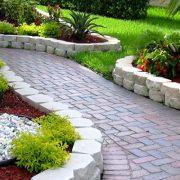Organic Landscaping Tips to Try at Home
The sun has made its first appearance for the year. Which means it’s time to walk in the park, sit in the grass, and have a picnic.
Design local landscapes
When you’re designing a new landscape, first analyze your site and soil and select the most suitable trees and plants for the location. The ideal planting mix should include low maintenance, drought tolerant, disease resistant, and native plant materials. And contain no more than 20 percent of turf areas, which should be planted with a seed mix that’s suited to your area.
Plant a variety of plants
Healthy landscapes need a mix of plants and trees, not just one species, to prevent pests and diseases from spreading. You can also plant densely to crowd out and suppress weeds. Prune only to remove dead or diseased branches.
Amend your soil
For optimal growing conditions, amend your existing soil with a mix of compost and topsoil. Use a mix of 50 percent pure compost (either yard waste or manure) plus 50 percent topsoil. Amend existing soils with compost to a depth of 6-12 inches.
Avoid chemicals
The use of synthetic fertilizers, herbicides, or pesticides will make it into the watershed so it’s suggested to stay away from these products. It’s a good idea to use only 100 percent organic fertilizers and supplements like bone meal, blood meal, kelp meal, and cow and chicken manure. You can find organic fertilizer at your local nursery or big name home improvement store.
Keep your lawn healthy
You can core aerate to improve lawn circulation and promote root growth and soil structure. When you mow, set your blades to 3-4 inches in height to encourage thicker turf which helps with weed control. Leave the grass clippings to decompose and to serve as mulch and natural fertilizer. Also consider using a phosphorus-free fertilizer for lawn applications. Excess phosphorus causes algae to build up in waterways and can disrupt the ecological balance. If you only fertilize your lawn twice a year, make one application in the spring and one in the fall. If you only fertilize once a year, make sure to do it in the fall.
Weed by hand
Weeding by hand can be meditative and relaxing! Rather than using toxic chemicals, control weeds by mechanical methods like pulling them by hand, layering mulch in garden beds, or burning with a weed torch. Learn about sheet mulching to control the spread of weeds.
Conserve water through proper irrigation
Water conservation is a growing priority in the states so we suggest watering less frequently, but for longer periods. This helps landscape plants grow deep roots that are less vulnerable to drought conditions. Install an irrigation system with timers to minimize water usage, a rain sensor to stop the irrigation system when it detects precipitation, and a minimum of four separate programs per cycle. This saves water that might otherwise puddle in compact soil or end up as runoff on slopes. To prevent evaporation, irrigate early in the mornings and in the evenings, rather than during the day.
Practice integrated pest management
This tactic uses natural systems to disrupt the physical environment of common garden pests, rather than using chemicals to kill them.
A few tricks:
- Remove material that is infested by pests
- Put netting over plants to prevent insects from reaching them
- Pick mites off plants by hand or use traps, rather than using chemical insecticides
- Introduce beneficial insects like ladybugs to control an aphid population
Install permeable landscaping
Landscaping are the elements of your garden like pavers and paths. Impervious materials like concrete and asphalt can prevent rainwater from reaching the ground and increase flows into nearby streams, which can damage habitat. When you’re installing new paths or a driveway, install permeable materials like gravel, pavers that allow water to seep in between, or permeable pavement.






